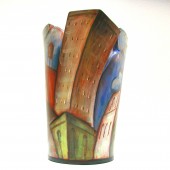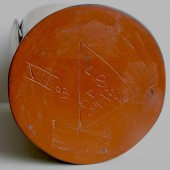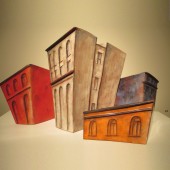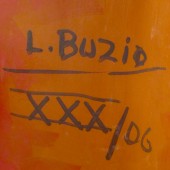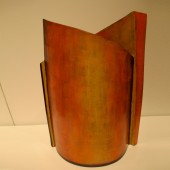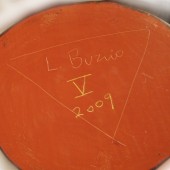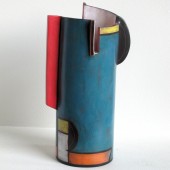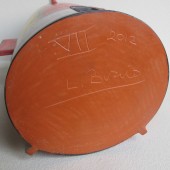![]() Printer version
Printer version
Lidya Buzio
1948Born Montevideo, Uruguay
2014Died Long Island, New York
EDUCATION
1967-1968Studied with the Spanish painter and ceramist, José Collell
PRIMARY WORK EXPERIENCE
1972Set up her first studio space in New York, New York
BIOGRAPHY
Lidya Buzio is known for sculptural forms that retain earthenware slabs as part of the finished object. The forms and surfaces reference cityscapes and abstractions using a bright color palette. Her process began with earthenware slabs that she manipulated into abstract vessel forms or multi-piece, small scale sculptures. The surfaces of the pieces were burnished until they became smooth and then were painted using colored slips, reburnished and fired. Finally they were waxed. This resulted in the fresco-like surfaces Buzio sought in her work.
Buzio’s early exposure to Joaquin Torres-Garcia’s Constructivist Universalist painting had been an ongoing influence on her ceramics as was her time with Jose Collell studying painting and then ceramics.
In 1997 Buzio moved to the north fork of Long Island where the sea became a prominent motif; the New York skyline provided a background to images of boats, the sea and to abstractions that relied on color and surface. Frustrated by life in the ceramic world she began to build constructivist wooden sculptures in the 1990s, however, she soon returned to ceramics.
PUBLIC COLLECTIONS
Arizona State University Art Museum, Tempe, Arizona
Berkeley Art Museum, Berkeley, California
Brooklyn Museum, Brooklyn, New York
Everson Museum of Art, Syracuse, New York
Hallmark Art Collection, Kansas City, Missouri
Honolulu Academy of Art, Honolulu, Hawaii
Kamm Teapot Foundation, Sparta, North Carolina
Long Beach Museum of Art, Long Beach, California
Los Angeles County Museum of Art (LACMA), Los Angeles, California
M.H. de Young Memorial Museum, San Francisco, California
Museum of Fine Arts, Houston, Texas
Museum of Fine Arts, Tai Pei, Taiwan
National Museum of History, Taipei, Taiwan
National Taiwan Museum of Fine Arts, Republic of China
Nelson-Atkins Museum of Art, Kansas City, Missouri
Nerman Museum of Contemporary Art, Johnson County Community College, Overland Park, Kansas
Racine Art Museum, Racine, Wisconsin
Rhode Island School of Design (RISD) Museum, Providence, Rhode Island
Smithsonian National Museum of American Art, Washington, D.C.
Spencer Museum of Art, Lawrence, Kansas
University of Iowa Museum of Art, Iowa City, Iowa
Victoria & Albert Museum, London, England
BIBLIOGRAPHY
Beardsley, John, Jane Livingston and Octavio Paz. Hispanic Art in the United States: Thirty Contemporary Painters and Sculptors. Houston, TX: The Museum of Fine Arts, Houston, 1987.
Buzio, Lidya. “Line and Rhythms.” Studio Potter 2, no. 11, 1985.
___________. “Ceramic Cityscapes.” Studio Potter 2, no.2, 1983.
Clark, Garth and Tony Cunha. The Artful Teapot. New York, NY: Watson-Guptill, 2001.
___________. American Ceramics 1876 to the Present. New York, NY: Abbeville Press, 1988.
Del Vecchio, Mark. Postmodern Ceramics. New York, NY: Thames & Hudson, 2001.
Genocchio, Benjamin. “Art Sites,” review. New York Times, September 17, 2006.
Lebow, Edward. “Lidya Buzio, Duple Rhythms.” Ceramic Arts 1, no.1, 1983.
Lynn, Martha Drexler. Clay Today: Contemporary Ceramists and Their Work. San Francisco, CA: Chronicle Books, 1990.
McCready, Karen. Twenty Artists: Contemporary American Ceramics. Newport Beach, CA: Newport Harbor Art Museum, 1985.
Morgan, Robert C. “Latin America Rediscovered: Lidya Buzio.” American Ceramics 15, no.1, 2006.
CV or RESUME: Click Here to Download
Source: Cecilia de Torres Gallery
Citation: "The Marks Project." Last modified February 15, 2024. http://www.themarksproject.org:443/marks/buzio







